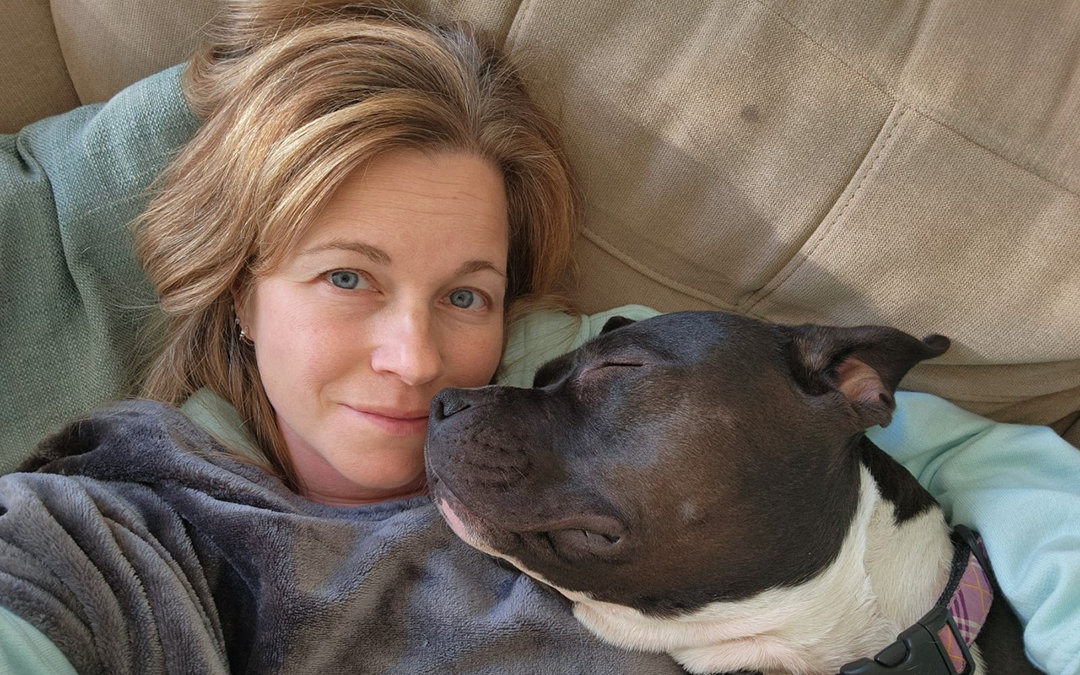Like humans, some dogs develop a neurological condition called epilepsy. Epilepsy is marked by the recurrence of unprovoked seizures caused by electrical surges in the brain. March 26th is World Epilepsy Awareness Day. In honor of North, an American Staffordshire Terrier, owned and loved by Elizabeth & Cory, this article discusses information about epilepsy in dogs.
North started having grand mal seizures around 14 months old. They were short, intense, and very scary to watch. They soon morphed into clusters of seizures (2 or more seizures in a short period of time). Grand mal seizures are not for the faint of heart! She was diagnosed as having Idiopathic Epilepsy one month later and is currently on 2 anti-seizure medications and a variety of herbal supplements. At almost 2 years old, her seizures are far from under control and the future is uncertain. North is a challenge, behaviorally and medically, but she’s very fortunate to have a family like the Staples. Managing North’s needs isn’t easy and Cory & Elizabeth are well aware that North may very well have been surrendered, rehomed, or worse if she hadn’t come home with their family in June of 2021. She’s a beloved part of the family and they try to keep life as normal as possible for North with lots of hikes, water play (her favorite!), training, and snuggles. She may be just a little spoiled but the Staples are determined to give North the best life possible, despite her health issues.
When asked for advice on how to cope with an epileptic family pet, Elizabeth says to try and keep calm during a seizure (something she still struggles to do) and talk to your pet in a soothing voice. Don’t move a dog who is seizing, but do try to keep them from hitting their head on hard surfaces. Keep a journal of seizure activity and be sure to have a veterinarian and a neurologist who are compassionate and willing to work as a team. Be cautious of the post-ictal seizure stage in which the dog can be out of sorts. In North’s case, seizures lessen her bite inhibition and she acts quite puppy-like, but with an adult set of teeth! Extra bully sticks and other things to chew on are a must. So is keeping a close eye on the dog/children interactions for the safety of all involved.
What Is Epilepsy?
Epilepsy is a type of seizure disorder, and it’s where it gets its name. At a basic level, a seizure results from abnormal neurological brain activity, which results in altered behavior and actions. Not every dog who experiences seizures receives an epilepsy diagnosis. Typically, an epilepsy diagnosis occurs after several seizures, but every situation is different. There are currently no known causes of epilepsy.
Signs and Symptoms
Depending on the type and size of a seizure, the signs vary. Epilepsy in dogs is similar to humans in that the severity of a seizure does not necessarily correlate to a more serious illness. Here are some signs and symptoms to watch out for if your pup has an epilepsy diagnosis or you suspect one:
- Paddling of arms and legs
- Stiffened neck and legs
- Uncontrollable bladder
- Shaking or trembling
Seizures can last from a few seconds to several minutes. It’s important to be very aware of their surroundings as certain environments, like being in the water or in areas where they can fall or have objects land on them, can put them in immediate danger.
Treatment Options For Epilepsy In Dogs
The most common treatment option for canine epilepsy is an anti-seizure medication. Once your pup begins taking the medication, they will likely have to stay on it for life. Some names of commonly prescribed anticonvulsant medications for dogs are phenobarbital, levetiracetam, and potassium bromide.
5 Ways To Help
If you have a dog with epilepsy, you can help them feel comfortable and safe. The following are 5 ways you can care for epilepsy in dogs.
Understand The Condition
The first step to caring for a dog with epilepsy is to learn about the condition. This is something you will naturally do as a responsible dog owner. There are two kinds of epilepsy – genetic and idiopathic.
Genetic Epilepsy is passed down from one generation of dogs to the next through genetics. Certain breeds of dogs are more prone to epilepsy than others.
Idiopathic Epilepsy is caused by unknown factors. It’s highly unpredictable and is often hard to predict when or why a seizure might occur. There are some factors that are thought to possibly cause seizures in dogs like stress, weather, or a change in schedule.
Many dogs with epilepsy live long happy lives. It’s not a curable condition, but it can be medically managed by a neurologist and/or veterinarian.
Keep A Log
If your dog has a seizure or a cluster of seizures, you’ll want to let your Veterinarian know about it. It is recommended that you keep a journal and write down any and all information that you can about the seizure, like:
- Date and time of seizure(s)
- Length of each seizure
- What was your dog doing when the seizure took place?
- A description or a video of the seizure – how severe was it?
You can include any other information you think could be relevant to your dog’s seizure. A log like this can be very helpful to manage your dog’s epilepsy.
During A Seizure
There are some things you can do to make sure your pet stays safe and as comfortable as possible during a seizure.
- Make sure they can’t fall off of a high place, like a couch or bed.
- Talk to your dog calmly during a seizure.
- Try to prevent them from hitting their head on hard flooring or surfaces.
- Don’t try to stop your dog’s movements during a seizure.
- Your dog may urinate and/or defecate during a seizure. This is normal.
- Don’t place your hand near your dog’s mouth during a seizure. Dogs sometimes clench their jaws while having a seizure and could accidentally bite you.
After A Seizure
Your dog might feel disoriented, hungry, or thirsty after a seizure. They may pace back and forth. Some dogs take as long as 24 hours or more to recover from a seizure, while others recover very quickly. Give your dog something sugary like ice cream or frozen yogurt to help stabilize their blood sugar. Keep the lights low and the energy calm. Let them dictate the recovery time and then return to “business as usual”.
Medications and Nutrition
In addition to the above tips, talk with your dog’s veterinarian about ways to manage symptoms with nutrition and anti-seizure medication. These things are used alongside medication to keep your pup comfortable, safe, and healthy throughout their lives.
At The Good Dog Spot, we help dogs live healthy, comfortable, and well-rounded lives. Contact us about how we can serve your dogs with special needs and conditions.
Call Us to book your spot (413) 534-1333
35 C North Chicopee Street Chicopee, MA 01020
139 King Street Northampton, MA 01060
ABOUT US
Our Mission is to ensure pet parents’ peace of mind by providing consistent, compassionate grooming services and a nurturing, safe and fun environment for pets to socialize and grow through our daycare and overnight programs.
Chicopee hours
- Monday 7:00am - 6:30pm
- Tuesday 7:00am - 6:30pm
- Wednesday 7:00am - 6:30pm
- Thursday 7:00am - 6:30pm
- Friday 7:00am - 6:30pm
- Saturday 8:00am - 4:00pm
- Sunday 8:00am - 9:00am
& 4:00 - 5:00pm
We are closed between 12:30-1:30 for lunch
Holidays: 8:00am - 9:00am & 4:00pm - 5:00pm
Northampton hours
- Monday 7:00am - 6:30pm
- Tuesday 7:00am - 6:30pm
- Wednesday 7:00am - 6:30pm
- Thursday 7:00am - 6:30pm
- Friday 7:00am - 6:30pm
- Saturday 8:00am - 4:00pm
- Sunday 8:00am - 9:00am
& 4:00pm - 5:00pm
We are closed between 12:30-1:30 for lunch
Holidays: 8:00am - 9:00am & 4:00pm - 5:00pm


